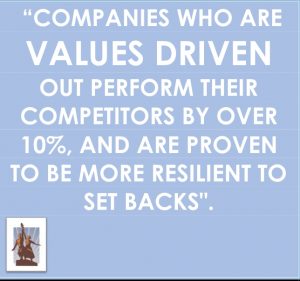Objectives and Key Results (OKRs for short) are changing how companies define and communicate success. Why not have a read through our free beginners guide to OKRs to get more information on how you can align and grow your company.
Lying at the heart of every organisation – whether you’re aware of them or not – are the values which influence its decision making, how it reacts and how it engages with clients and the public. Some businesses may have already tackled the creation of these values, driven by marketing in order to seemingly strengthen the brand. In reality, however, an organisation’s values have a far greater role to play – especially in the realm of successful performance management.
 The First Step to Successful Performance Management
The First Step to Successful Performance Management
One of the greatest challenges businesses face once they’ve cemented their core values, is making sure they’re used for more than just new employee inductions and to hang as a plaque on the wall in reception. Instead, companies should be aiming to fully integrate their values into the business and their team’s work.
In fact, a huge amount of value can be driven by working them into processes such as recruitment (do candidates demonstrate a good fit with the values?), reward (has someone demonstrated excellent use of the core values in their work?), and especially management of individual performance – the latter is where our focus lies in this article.
Relating Values to Individuals
The great thing with creating clear, shared, company-wide values is that it’s one of the most visible steps you can take to demonstrating your commitment to better performance – and it’s an opportunity for everybody to get involved (they are ‘shared’ values, after all!).
Once you’ve settled on the business’ values – preferably after discussing with teams and gaining input and insight from every individual – it’s time to gain some support from your employees. I recommend cascading them by first, asking your teams to look at how the values should show up in their work and agreeing how they can both support and hold each other to account in living them. Second, each team member should be invited to draft up statements of how these values should show up in their role, as well as detailing the related responsibilities they hold, how they fit into the company, and their own measure of success.
This provides an opportunity for individuals to seek support from teammates in order to do justice to their role and the core values, opening up the potential for a better, more cohesive form of teamwork. This exercise is simple and gets your teams involved in every stage of the values process, almost guaranteeing loyalty and brand awareness from within.
Keep Up the Good Work
It’s important though, once your values are set and employees know their responsibilities, that you keep referring back to them when measuring success and evaluating individual progress. There’s a very simple reason for this: defining a set of values and then not abiding by them has been shown to drive up cynicism and weaken trust, impacting on internal dialogue and personal mindset.
In short, you will have wasted a lot of time and effort, and people may personally feel let down that their opinions and efforts didn’t come to fruition.
On the other hand, an organisation that takes these values and really runs with them – well, they’re proven to be more likely to benefit from positive effects on certainty, relatedness and fairness.
Laying Foundations
So there you have it: the first element of a successful performance management system. If you follow this through, you’ll be one step closer to a more productive, better engaged and happier team in no time. But remember that this is just the foundation – to maximise success, you need the other eight elements in place too. Tune in next time for the second element: creating a growth mindset.
In the meantime, please feel free to connect with me on LinkedIn – especially if there’s anything you’d like to discuss on the topic!
If you’d like to find out more about the changing world of performance management, please feel free to download my recent research paper, available over on my website.

